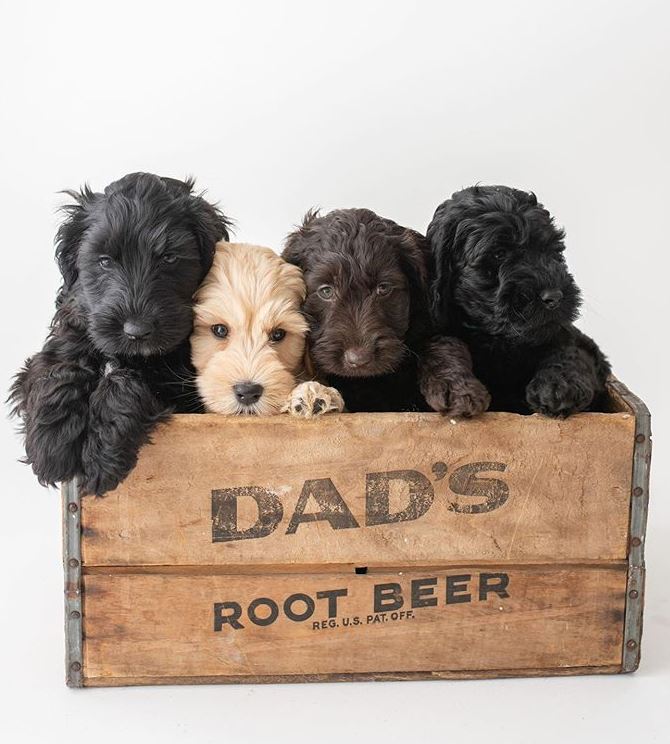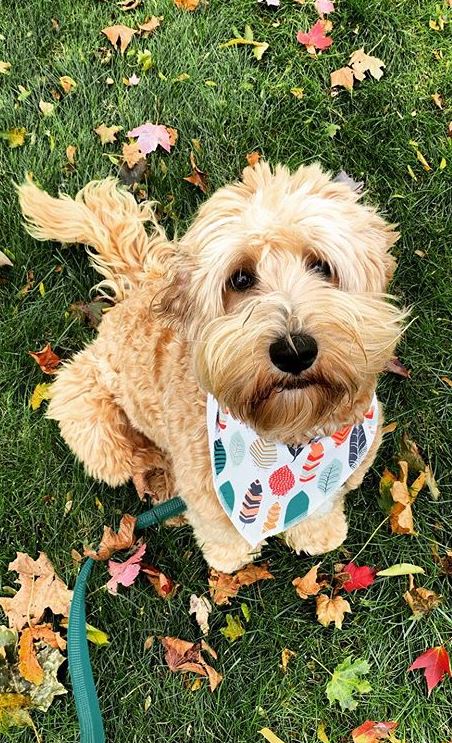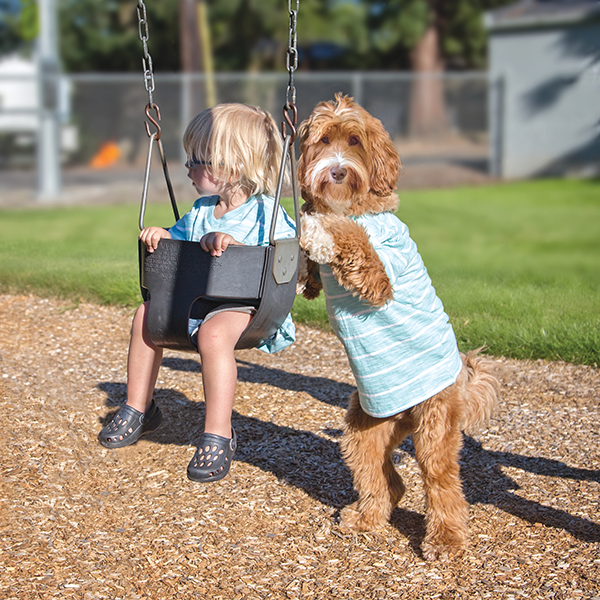If you are thinking about adopting a Labradoodle puppy for the first time, then you might find the terminologies a bit confusing. Most people think that a Labradoodle is just a crossbreed of a Labrador and a Poodle. Unfortunately, it’s not that simple. Labradoodles are also known as “Designer Dogs.” There are several varieties of Labradoodles, and they are all quite different from one another.
The puppies from a Labrador and a Poodle are referred to as first-generation (F1) Labradoodles. When you cross a first-generation (F1) labradoodle with another first generation (F1 or higher) labradoodle, the puppies will be second generation (F2) Labradoodles. You get the third generation (F3) puppies from the second generation (F2) Labradoodles and so on. The generations of the parents determine the generation of the puppies. Then the backcross or an F1B is crossed with a first-generation labradoodle and a poodle. Now you can see how the terminologies can get so complicated and confusing.

Contents
Early Generation Labradoodle
So basically, all the Labradoodles that have come from only Labrador and Poodle lines are considered as “Standard” Labradoodles and also known as Early Generation Labradoodle, American Labradoodle, British Labradoodle, and Labradoodle Origin. All these names or terms can be used interchangeably to refer to “Standard” Labradoodles.
What is an Australian Labradoodle?
Australian Labradoodles are very different and distinct from the standard or early generation Labradoodles. Unlike Labradoodles, Australian Labradoodles’ lineage is more complicated. An Australian Labradoodle also has DNA from other dogs. They have six different parent breeds: Labrador, Poodle, English Cocker Spaniel, American Cocker Spaniel, Curly Coat Retriever, and Irish Water Spaniels. Standard or early generation Labradoodles are solely cross between a Labrador and a Poodle.
The early Labrador-Poodle crosses in Australia produced large dogs, but they were often stubborn and willful with high energy levels. It was therefore decided to introduce another breed. At first, the breeders used two Irish Water Spaniels. Later, English and American Cocker Spaniels were introduced. The result was exactly what the breeders were trying to achieve. They created a breed with a good temperament, larger bone structure than the Poodle, and, most importantly, the Cocker Spaniel’s soft fleece coat. Even today, some breeders are still using Cocker Spaniel in their bloodlines.
The name Australian Labradoodle was first coined in 2004 to describe the lines of multi-generation Labradoodles with extended pedigrees. Two kennels in Australia, Tegan Park, and Rutland Manor, set up by mother and daughter Beverley Manners and Angela Wetzel Cunninghamwhich started breeding them in the early 1990s.

In this blog, we will talk about the difference between an Australian Labradoodle and a Labradoodle (Standard or Early Generation) to help you decide to pick the right puppy for you and your family.
Australian Labradoodles vs Labradoodles
A Labradoodle is a cross between a Labrador and any of the three sizes of a Poodle. A Labradoodle can be F1, F2, F3, multi-generation, etc. but it will only have Labrador and Poodle genes. On the other hand, Australian Labradoodles are all fifth-generation (F5 or higher) and have six possible parental breeds of Labrador, Poodle, Irish Water Spaniel, Curly Coat Retriever, English Cocker Spaniel, and American Cocker Spaniel.
High generations and different parental breed of Australian Labradoodles make a big difference. The main differences between an Australian labradoodle and a standard labradoodle are in breed consistency, temperament, size, and coat types.

Appearance and Consistency
Early Generation Labradoodles are considered a low generation. There is very little consistency in the litters of puppies in early generation. Initially, if you cross a Labrador with a Poodle, the resulting puppies vary considerably in size, coat type, and temperament. When you move to the second or third generations, it gets more complicated. A second or third generation labradoodle might look like a poorly bred Labrador or a Poodle and nothing like a Labradoodle.
On the other hand, Australian Labradoodles are more consistent, primarily because they are higher generations. Physical characteristics and attributes are more predictable and consistent in the higher generations. Every puppy in an Australian Labradoodle litter will be recognizable as an Australian Labradoodle and resembling its parent’s breeds are very rare.
In general, standard or early generation Labradoodles have a scruffy look, but multi-generations and Australian Labradoodles look more like teddy bears.
Personality and Temperament
The only reason why Labradoodles have become so popular is their temperament. The Labradoodle combines the gentleness and steadfastness of the Labrador with the intelligence and alertness of the Poodle. The Poodle is also an instinctual dog, which is why sometimes you may wonder how your Labradoodle knows what you are thinking! They are loyal and regarded as easy to train. That’s why many organizations and people use Labradoodles as service or therapy dogs.
On the other hand, the Australian Labradoodle is more than a Labrador crossed with a Poodle, as it has several ancestors. They are the best of everything mixed together. Australian Labradoodles are calmer, balanced, intuitive, intelligent, mature, and easily trained. They are excellent with young children, which makes them an ideal family member. They are full of fun to be around, whether playing indoors or outdoors.

Coat Type
There are three main coat types with Labradoodles – hair, wool, and fleece. And there are further variations within these three types. For example, a hair coat can be straight, wiry, or wavy, and a fleece coat can be almost straight, wavy, or curly. It is difficult to predict what sort of coat your Labradoodle pup will grow up to have. The type of coat may vary even within pups of the same litter, and often a puppy’s coat will change before he reaches adulthood. A Labradoodle is not a hypoallergenic breed like its Poodle parent. If your pup takes after his Labrador parents or grandparents, he/she will most likely molt.
An early generation or F1 cross has a good chance of having a coat with at least some similarities to that of the Labrador parent. That’s why most early or first-generation Labradoodles shed their coats and are not suitable for allergy sufferers.
Australian Labradoodles, on the other hand, are many more generations away from the shedding Labrador. Australian Labradoodle breeders and other breeders of multi-generation pups may claim that they are allergy-friendly and don’t molt. While this may be true for some dogs but it is certainly not true of all Australian Labradoodles. According to the Kennel Clubs of the USA and UK, there is no such thing as a non-shedding dog.
Size
Size, color, and coat are just some of the variable factors with Labradoodles – even within the same litter. Some standard or early generation Labradoodles are extremely large with high energy levels. They will require a great deal more daily exercise than a Miniature or even a Medium. As with Australian Labradoodles, there are three sizes (Standard, Medium, and Miniature), same as early generation Labradoodles. You must decide which size best fits in with your household and daily routine.
The chart below will show you the standard height and weight of an Australian labradoodle and an early generation labradoodle.
| Labradoodle Types | Height | Weight |
| Standard Labradoodle | 53 cm – 63 cm (21 – 25 inches) | 23 kg – 30 kg (51 – 66 lbs) |
| Medium Labradoodle | 43 cm – 52 cm (17 – 20 inches) | 13kg – 20 kg (29 – 44 lbs) |
| Miniature Labradoodle | 35 cm – 42 cm (14 – 16 inches) | 7 kg – 13 kg (15 – 28 lbs) |
| Standard Australian Labradoodle | 53 cm – 63 cm (21 – 25 inches) | 23 kg – 30 kg (51 – 66 lbs) |
| Medium Australian Labradoodle | 43 cm – 52 cm (17 – 20 inches) | 13kg – 20 kg (29 – 44 lbs) |
| Miniature Australian Labradoodle | 35 cm – 42 cm (14 – 16 inches) | 7 kg – 13 kg (15 – 28 lbs |
Should you get an Australia labradoodle?
The Australian Labradoodle is popular throughout Australia and the USA, while the UK probably has a higher percentage of Labradoodles.
Australian Labradoodles carry more than just Labrador and Poodle bloodlines. When you adopt an Australian Labradoodle, you have a much better idea of exactly what you’re getting. The size, coat, temperament, appearance, allergy friendliness, and non-shedding qualities of Australian Labradoodles are a lot more predictable and consistent. These are the qualities that made Australian Labradoodles more popular than the standard Labradoodles.
Conclusion
Regardless of what type of Labradoodle you have or are thinking of getting, there is no denying that they are incredibly appealing canines. This, coupled with their friendly, often amusing personality, loyalty, and suitability for family life, has all contributed to the Labradoodle’s popularity. Labradoodle puppies are very attractive. So, make sure you do your research about the type and size that you want and then pick a good breeder. Because the sight of a litter of fluffy Labradoodle pups may well be too much to resist.
We know they are all so adorable, but which one did you pick? Please let us know in the comments below.
Thanks for explaining that Labradoodles require more daily exercise and are a kind and smart breed. My sister wants to get her kids a dog so they can least some responsibilities. She will be fascinated to have a Labrapoodle in her home because she prefers medium or big size dogs.
We picked the Australian Labradoodle. She is 2 yrs now and quite amazing. Beautiful coat, very loving temperament and amazingly athletic. We researched the breed for a year and took time finding a good Breeder. We have had many dogs but Charlie is by far our favorite of all.
What breeder did you purchase from?
Thank you for the information! We are getting an australian labradoodle in mid-May, specifically because of the allergen factors and the size of the dog. We did not quite understand the bloodlines, but appreciate you laying it out. Found a great breeder, and have met other lovely dogs who were adopted from her. You are right – those puppies are adorable!
We got a mini Australian Labradoodle for comfort after our son died. She has been the best therapy. Sweet, gentle and easy. Our neighbors got a dog because of her, but didn’t ask or understand the difference between all of the doodles, so the one they ended up with (Goldendoodle) is hyper and is not easily training.
I have a miniature labradoodle however his size is actually medium 17kg.
His dad is a miniature poodle and his mum is a labradoodle (don’t know if F1 etc).
I assume my dog is an F1B -?
He does not shed (wool fur) and has a lovely temperament, he can get hyper and you have to calm him on occasion, however I find this endearing.
He is a great watch dog and only barks if he hears something outside he is unsure of.
He is totally non aggressive and will never retaliate when dogs are aggressive towards him.
He is a great companion, I got him a few years after my husband passed away.
Maybe I missed it, but who do I contact to adopt an Australian Labradoodle and how much should I expect to spend for a multigenerational puppy?
I chose a multigenerational, miniature, Australian Labradoodle due to my allergies. Our pup is only 10 weeks old now and is sooooo smart! He is worth every cent and the long wait to finally arrive. I chose a WALA approved breeder and couldn’t be happier!!
Hey Rebecca! Check for reputable Australian Labradoodle breeders through the WALA (Worldwide Australian Labradoodle Association) website. They’ll give you a ton of info on how to locate a reputable breeder. Good luck in your search!
Brought home a Multigen Australian labradoodle
On November 15th, she was 8 weeks old
First let me say as a single parent ( and not a young one) the first two weeks were touch & go but that was all it took!
Two weeks and my girl River was sleeping through the night … totally house trained , could sit , high five , & come on command
Her little teeth are still sharp but I know they’re bothering her so I’m not too concerned about her biting & chewing … I did have to enroll her at a very good doggie day care a couple of days a week for her well being as well as mine ( they are very energetic as puppies & I was finding it hard to keep up )
The good news it that she loves it & they love her♥️
Wouldn’t change my decision for the on her way to being the love of my life
We just adopted our first MINI Australian Labradoodle after having lost our Maltipoo last May at 16 yrs old. “Boomer” will join our family at the end of Jan. 2021 at 8 weeks old. Breeder is Tampa Bay Australian Labradoodles. They are AWESOME and right here in our area, although they DO have a long waitlist. From everything I’ve read in this article (all very helpful, thank you), we know we’ve made the right choice and look forward to welcoming the little guy into our home.
I have a ten month old Multi generational Australian Labradoodle whom I just love! He is adorable, very smart, easy to train, sensitive. He can e a bit hyper when excited,is a great runner, loves to play, He wouldn’t hurt a fly.
Loved your information. I got him from excellent breeders.. I highly recommended Cascade Trail Doodles near Sedro Wooley, Wa.
3 years ago I lost 2 dogs that I had for 14 years and was heart broken. I saw a picture of a Aussie Doodle and fell in love! So I got one and now 3 years later I am getting another one. I don’t think I have ever come across a smarter breed. If I had room I would have more. Swinging Gate is my breeder and they are super!
How much are your puppies?
Thank you for this very explicit information. It was very helpful. We got a miniature labradoodle last November when he was 10 weeks old. He is a red F2 and a wonderful dog. When compared to numerous other Aussie labradoodles we can definitely see the difference in the breeds. He has darling face, very smart, does not bark, very friendly with people, children, all dogs, and very sweet. We are an older couple and although we do take him on 2 walks a day he has a very calm temperament. We purchased him from a breeder off of a broker site and have been extremely pleased. We definitely prefer the labradoodle breed.
I have read with interest the great information and loving comments. We have a 13 week f1B labradoodle and are impressed with her intelligence and calm puppyhood (She does have a lot of energy but considered by all as a “good puppy”.) She was night trained in one night and house trained in two weeks, except for rare puppy accidents. We only need to show what we expect one time. This is our first inside dog and are so happy we chose her.
I’m thinking of breeding her with an Aussie Labradoodle. Any thoughts to share?
So glad that you have a wonderful dog—I have two Aussie labradoodles myself! Please consider leaving the breeding to professionals however; or if you must, learn what you can from WALA (Worldwide Australian Labradoodle Association). An f1B and Aussie labradoodle doodle cross could produce, due to atavism, undesirable physical or behavioral traits. My best advice would be to find a puppy from reputable multigenerational Australian Labradoodle breeder (must be WALA certified) and then enjoy both your fabulous dogs! That said, as I write this, Violet my two year old, is barking her head off at a moth flying around the room. It’s a bark that could cut glass but I find it and her adorable nonetheless.
Good Luck!
CGreen, New York City
I have an Aussie Labradoodle from a reputable breeder here in Michigan. My husband died, then a few years later I had to euthanize my Shepard/Golden mix due to crippling and painful arthritis. I have always had big dogs and due to my age, decided on a medium Labradoodle. He is just over a year old now, loves playing outdoors and cuddling. Never met a stranger, just new friends both canine and human. He’s a Velcro dog, always likes to keep me in sight but when I’m gone for any length of time an hour or over a trusted neighbor babysits and he is happy to have new company. I’m so very glad I got him! He’s my best buddy, loves walks and riding in the car. Every new puppy owner has some bumpy moments, but I’m so happy with him and the road gets smoother every day. This breed truly wants to please you and do what you ask of him. Patience and consistency are everything in training any puppy and Aussie Labradoodles are quick to learn.
My little Aussie Labradoodle, her name is Izzy, she is just a wonderful addition to our family. She is a reddish golden color, with curls galore; she has a white star on her breast and two white socks on her front paws. She is a loving dog, full of play and loves to run around the backyard. Her temperament is fantastic, she is soooo smart and trainable. I can highly recommend this bread to anyone. We have always had golden retrievers or yellow labradors, two dogs at a time. Issa is a wonderful companion with our current Lab, Sergeant. No problems have by a new puppy at all.